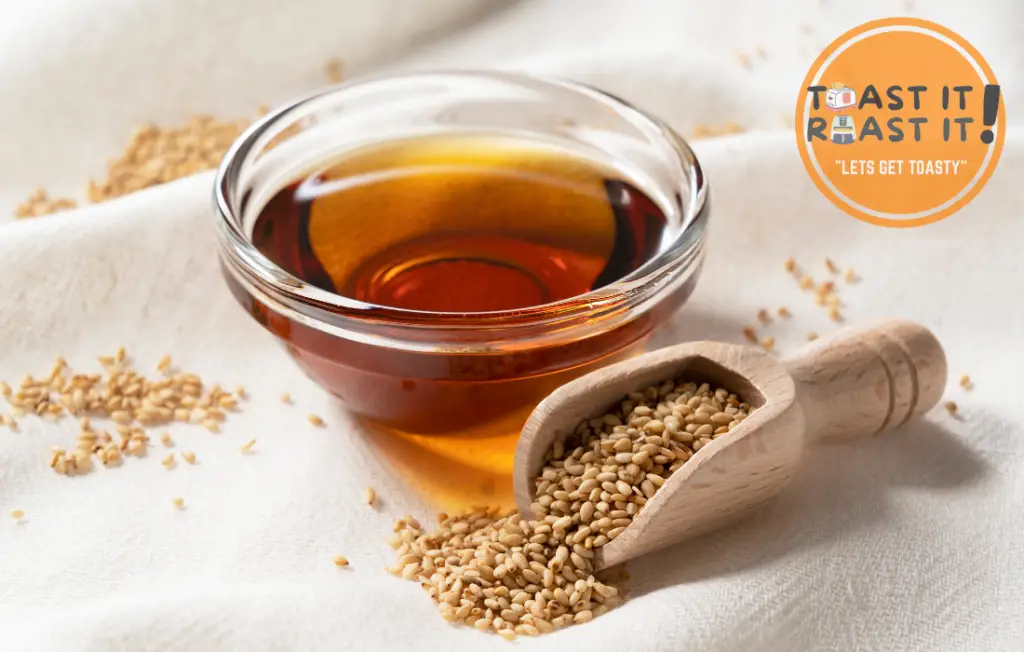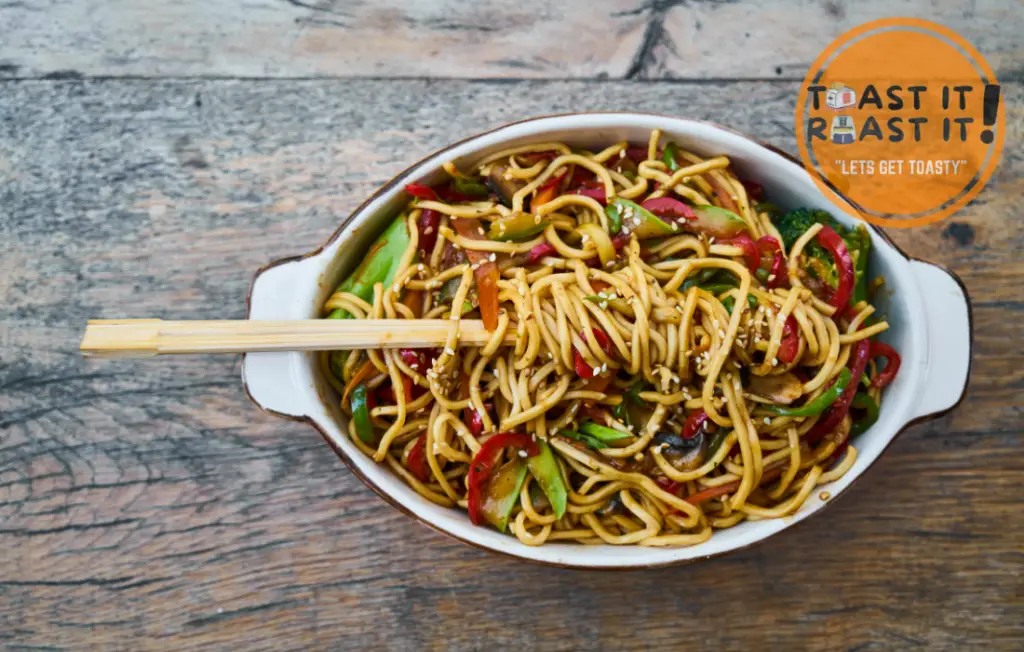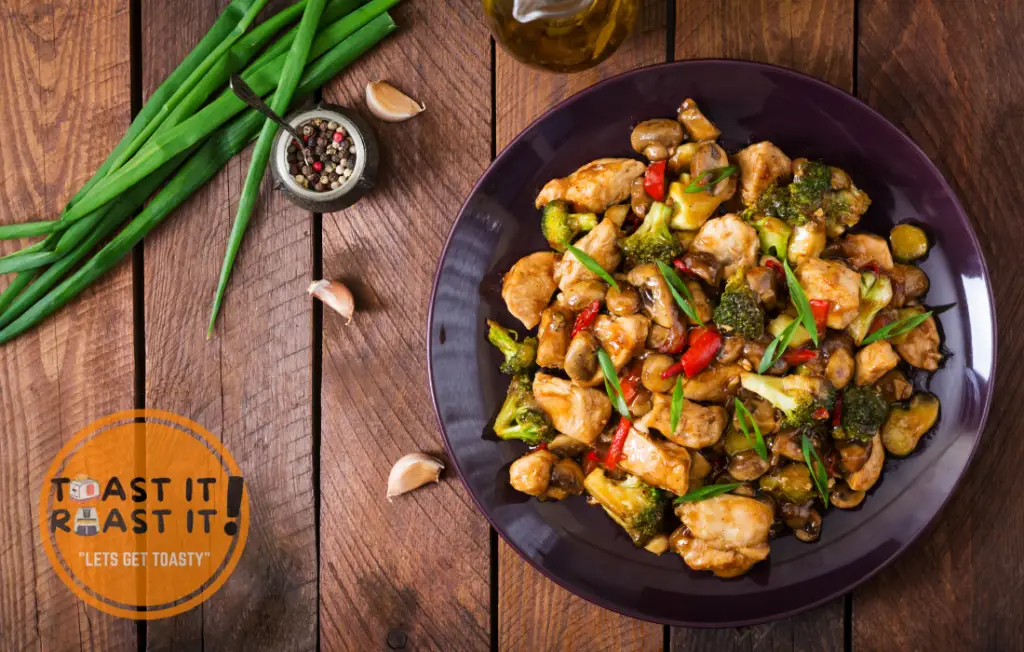Toasted sesame oil is a star ingredient when it comes to stir fry, adding rich, nutty flavor to countless Asian dishes. As home cooks, we often wonder how much toasted sesame oil to use in stir fry for that perfect balance of taste and health.
When using toasted sesame oil in a stir fry, it’s best to start with 1-2 teaspoons and adjust according to your taste preference. As a powerful flavor enhancer, a little goes a long way. In fact, studies show that the rich aroma and taste of toasted sesame oil can be achieved using just 0.5% to 1% of the oil in your recipe, allowing you to maintain a healthy and delicious meal without overpowering the dish.
In this article, we’ll explore the benefits of using toasted sesame oil in stir fry, how to optimize its use in various dishes, and share tips for creating delectable and healthy homemade meals that cater to diverse palates and dietary preferences. So, let’s dive into the world of stir fry and discover the magic of toasted sesame oil!

- The role of toasted sesame oil in stir fry
- Choosing the right oil for your stir fry
- Sesame Oil vs Toasted Sesame Oil
- How to use toasted sesame oil in different stir fry dishes
- Tips for optimizing the use of toasted sesame oil
- Frequently Asked Questions
- Stir fry meal planning and recipe inspiration
- Final thoughts on using toasted sesame oil in stir fry
The role of toasted sesame oil in stir fry
Toasted sesame oil is a versatile ingredient that lends a distinctive touch to stir fry dishes. Let’s take a closer look at the various roles it plays in this popular cooking technique.
Flavor enhancement: Toasted sesame oil is known for its rich, nutty flavor that adds depth to any stir fry. The toasting process releases aromatic compounds that enhance the taste of vegetables, meats, and tofu alike. When used in small amounts, it can make a world of difference in your stir fry, bringing an authentic Asian touch to your homemade meals.

Smoke point and high heat cooking: The smoke point of toasted sesame oil is around 350°F (177°C), which is lower than other cooking oils typically used in stir frying, such as peanut oil or canola oil. However, when used in combination with these high smoke point oils, toasted sesame oil can still excel in high heat cooking. This approach ensures the oil doesn’t break down, while still allowing the delightful aroma and taste of toasted sesame oil to shine through.
Health benefits: While toasted sesame oil does contain a moderate amount of saturated fat, it also boasts numerous health benefits. Rich in antioxidants and polyunsaturated fats, this oil can help lower cholesterol and protect your heart. Additionally, toasted sesame oil contains lignans, which have been shown to have anti-inflammatory and antioxidant properties. By using it sparingly in your stir fry, you can enjoy these benefits without compromising on taste.
Choosing the right oil for your stir fry
Selecting the right oil for your stir fry can have a significant impact on the flavor, cooking technique, and health aspects of your dish. Let’s compare various cooking oils and explore their smoke points and health benefits.
Comparison of cooking oils:
When it comes to stir frying, the smoke point and nutritional profile of the oil play essential roles. While toasted sesame oil imparts a unique flavor, its relatively low smoke point makes it better suited for finishing touches or combined with other high smoke point oils. Here are some popular cooking oils used in stir frying:
- Peanut oil: High smoke point and neutral flavor, making it ideal for high heat cooking.
- Canola oil: High smoke point and a mild flavor that won’t overpower the dish.
- Avocado oil: High smoke point with a buttery flavor, but can be expensive.
- Coconut oil: Moderate smoke point, but its strong flavor may not suit every dish.
Cooking oil smoke points
| Oil | Smoke Point (°F) | Smoke Point (°C) |
|---|---|---|
| Toasted Sesame | 350 | 177 |
| Peanut | 450 | 232 |
| Canola | 425 | 218 |
| Avocado | 520 | 271 |
| Coconut | 350 | 177 |
Health benefits of various oils
| Oil | Health Benefits |
|---|---|
| Toasted Sesame | Antioxidants, polyunsaturated fats, heart-protective, anti-inflammatory |
| Peanut | Vitamin E, monounsaturated fats, heart-healthy, lower LDL cholesterol |
| Canola | Low in saturated fat, high in monounsaturated fat, source of omega-3 and omega-6 fatty acids |
| Avocado | High in monounsaturated fats, lowers bad cholesterol, improves heart health |
| Coconut | Medium-chain triglycerides, increase HDL cholesterol, energy source for brain and body |
While toasted sesame oil adds a delightful flavor to stir fries, it’s essential to consider the cooking oil’s smoke point and health benefits to make the best choice for your dish. Combining toasted sesame oil with a high smoke point oil can help you achieve a perfectly cooked, flavorful, and healthy stir fry.
Sesame Oil vs Toasted Sesame Oil
Sesame oil and toasted sesame oil are both derived from sesame seeds, but they differ in several ways due to their distinct production methods and flavors. Let’s take a closer look at the differences between these two oils, including their processing techniques, taste profiles, and ideal culinary uses.

- Production process: Sesame oil is extracted from raw, unroasted sesame seeds, either through cold-pressing or expeller-pressing methods. Cold-pressed sesame oil retains more nutrients and has a lighter flavor, while expeller-pressed oil is exposed to higher temperatures and may lose some nutritional content.
Toasted sesame oil, on the other hand, is made from roasted sesame seeds. The seeds are first toasted until they develop a rich, golden brown color and release their signature aroma. Then, they are pressed to extract the oil, resulting in a more robust and flavorful product.
- Flavor profile: The flavor of sesame oil is relatively mild and almost neutral. It imparts a subtle nuttiness to dishes without overpowering the other ingredients. This makes it an excellent choice for cooking, sautéing, and as a base for dressings and sauces.
Toasted sesame oil boasts a much more pronounced, bold, and nutty flavor. The roasting process deepens the taste and imparts an unmistakable toasted sesame aroma. Its strong flavor makes it ideal for adding a finishing touch to dishes or using sparingly as a seasoning.

- Culinary uses: Sesame oil is versatile and suitable for a wide range of culinary applications. Its mild flavor and relatively high smoke point (around 410°F or 210°C) make it ideal for stir frying, sautéing, and grilling. It also works well as a base for salad dressings, marinades, and sauces.
Toasted sesame oil, with its intense flavor and lower smoke point (around 350°F or 176°C), is best used as a finishing oil or seasoning. It is typically added near the end of cooking or drizzled over dishes to add a burst of flavor. Its bold taste is perfect for enhancing stir fries, noodle dishes, and soups, as well as for seasoning meats, vegetables, and tofu.
While sesame oil and toasted sesame oil both originate from sesame seeds, their differences in production methods and flavor profiles make them suitable for various culinary applications. Regular sesame oil is great for high heat cooking, whereas toasted sesame oil shines as a finishing oil that adds a punch of nutty, aromatic flavor to dishes.
How to use toasted sesame oil in different stir fry dishes

Toasted sesame oil can work its magic in various stir fry dishes, enhancing flavors and adding that “je ne sais quoi” to your culinary creations. Let’s explore some tasty stir fry options and see how we can give them a unique Caribbean flair with toasted sesame oil.
Vegetable stir fry: A vegetable stir fry is the perfect canvas for toasted sesame oil. Start by stir frying your favorite veggies (like bell peppers, onions, and broccoli) in a high smoke point oil, such as peanut or canola oil. Once the veggies are cooked, drizzle a teaspoon of toasted sesame oil over the top and mix well. To add a Caribbean twist, toss in some pineapple chunks and a splash of lime juice, making your taste buds dance with every bite.
Chicken stir fry: For a scrumptious chicken stir fry, marinate your chicken pieces in a blend of soy sauce, ginger, garlic, and a touch of toasted sesame oil. Cook the chicken in a high smoke point oil until fully cooked. To finish, add a teaspoon of toasted sesame oil for that extra layer of flavor. Serve over rice with a sprinkle of chopped cilantro and a side of spicy Caribbean hot sauce.
Shrimp stir fry: Shrimp and toasted sesame oil are a match made in heaven. Sauté your shrimp in a high smoke point oil with garlic, ginger, and a dash of your favorite Caribbean spices. When the shrimp are nearly cooked, add a teaspoon of toasted sesame oil for that nutty depth. Combine with cooked veggies, serve over rice, and garnish with lime wedges for a delightful island-inspired feast.
Tofu stir fry: To give your tofu stir fry a Caribbean kick, marinate the tofu in a mixture of soy sauce, lime juice, and a dash of toasted sesame oil. Cook the tofu in a high smoke point oil until golden and crispy. Toss in your favorite veggies, and once they’re cooked, drizzle a teaspoon of toasted sesame oil to enhance the flavors. Top with chopped scallions and serve over a bed of coconut-infused rice for a true taste of the tropics.
Tips for optimizing the use of toasted sesame oil
Making the most of toasted sesame oil in your stir fry dishes is an art in itself. Let’s dive into some tips that will help you bring out the best of this flavorful oil and enhance your cooking skills.
Toasting sesame seeds: If you want to add an extra layer of nuttiness and texture to your dish, try toasting sesame seeds and sprinkling them over your stir fry. To toast sesame seeds, place them in a dry skillet over medium heat, stirring occasionally until they turn golden brown and fragrant. Be attentive, as they can burn quickly! Once toasted, add them to your dish for a delightful crunch and a boost of toasted sesame flavor.

Adjusting recipe quantities: When using toasted sesame oil, remember that less is often more. Start with a small amount (1-2 teaspoons) and adjust according to your taste preference. You can always add more if needed, but it’s difficult to remove excess oil if you’ve added too much. Finding the right balance between the rich flavor of toasted sesame oil and other ingredients in your dish is key to creating a harmonious, delicious meal.
Aromatic oils and seasonings: To optimize the use of toasted sesame oil, consider pairing it with other aromatic oils or seasonings to achieve a complex flavor profile. For example, you can combine toasted sesame oil with garlic, ginger, or lemongrass for an Asian-inspired stir fry. Alternatively, explore Caribbean spices like allspice, thyme, and Scotch bonnet peppers to give your dish an island twist. By experimenting with different flavor combinations, you can elevate your stir fry dishes to new heights.
Frequently Asked Questions
When should I add sesame oil in a stir fry?
To make the most of its rich, nutty flavor, it’s best to add toasted sesame oil near the end of cooking your stir fry. This ensures the oil doesn’t overheat and lose its distinct taste. Drizzle a small amount (1-2 teaspoons) over the cooked ingredients, mix well, and then serve.
Can I substitute sesame oil in stir fry recipes?
Yes, you can substitute sesame oil in stir fry recipes. If you don’t have toasted sesame oil, consider using other flavorful oils such as olive, peanut, or avocado oil. However, keep in mind that the taste profile will be different. Alternatively, you can use a neutral oil, like canola or sunflower, and add other seasonings or spices to compensate for the missing sesame flavor.
What is the difference between sesame oil and toasted sesame oil?
The main difference between sesame oil and toasted sesame oil lies in the manufacturing process and flavor profile. Sesame oil is made from raw, unroasted sesame seeds and has a mild, almost neutral flavor. Toasted sesame oil, on the other hand, is made from roasted sesame seeds, which gives it a darker color and a bold, nutty taste. These unique characteristics make toasted sesame oil ideal for flavor enhancement in various dishes, including stir fries.

What are some healthy stir fry options?
To create a healthy stir fry, focus on using plenty of colorful vegetables, lean proteins (like chicken, shrimp, or tofu), and a modest amount of oil. Opt for high smoke point oils with health benefits, like canola or avocado oil, for the actual stir frying process. Use toasted sesame oil sparingly as a finishing touch to enhance the flavor without adding excessive fat. Additionally, consider using whole grain rice or noodles for added fiber and nutrients.
How can I improve the taste of my stir fry?
To elevate the taste of your stir fry, experiment with different seasonings, spices, and sauces. Try incorporating fresh garlic, ginger, and aromatic herbs like cilantro or basil. You can also add a splash of soy sauce, fish sauce, or oyster sauce for extra depth and umami. Finally, don’t forget the power of toasted sesame oil – a small amount drizzled at the end can take your stir fry to new heights!
Stir fry meal planning and recipe inspiration
When it comes to whipping up a satisfying meal that’s packed with flavor, stir fries are the way to go. They’re versatile, quick, and adaptable to various dietary preferences. Let’s explore some meal planning ideas and recipe inspiration that’ll have your taste buds singing for joy.
Quick meal ideas: Stir fries are the perfect solution for busy weeknight dinners. Just prep your ingredients, grab your trusty wok or skillet, and create mouthwatering meals in no time. Some quick stir fry ideas include:
- Beef and broccoli
- Teriyaki chicken
- Spicy Thai basil shrimp

Vegetarian and vegan options: Stir fries make it easy to enjoy a plant-based meal without sacrificing flavor. Swap out animal proteins for tofu, tempeh, or a medley of your favorite vegetables. Try these vegetarian and vegan delights:
- Kung Pao tofu
- Veggie-packed lo mein
- Sweet and sour seitan
Fusion food and international flavors: Stir frying is an excellent opportunity to explore international flavors and create fusion dishes that’ll impress your friends and family. Consider experimenting with different sauces, spices, and ingredients from various cuisines:
- Korean-inspired spicy gochujang stir fry
- Indian-style vegetable curry stir fry
- Mediterranean shrimp and vegetable stir fry
Final thoughts on using toasted sesame oil in stir fry
Finding the perfect balance and daring to experiment with flavors are key ingredients to mastering the art of stir frying with toasted sesame oil. Embrace the unique flavors that Asian cuisine has to offer and use that rich, nutty sesame oil to take your dishes to new heights.
Remember that creating delicious and healthy homemade meals is all about finding the right mix of ingredients, seasonings, and cooking techniques. With toasted sesame oil as your secret weapon, you’ll be serving up irresistible stir fry dishes that’ll have everyone asking for seconds. So go ahead, channel your inner chef, and stir up a masterpiece in your kitchen!

